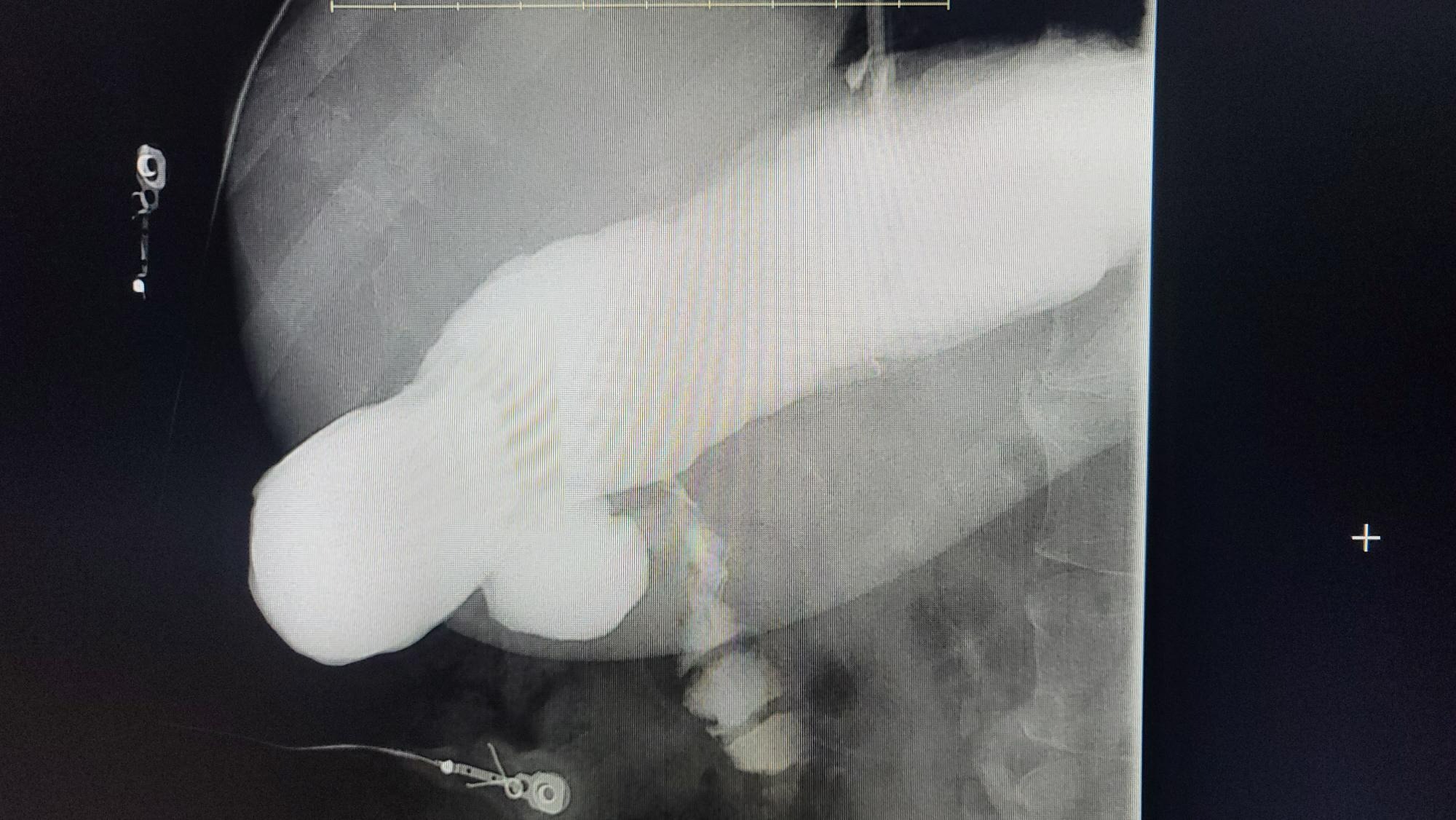Back
Poster Session E - Tuesday Afternoon
E0054 - A Rare Cause of Small Bowel Obstruction
Tuesday, October 25, 2022
3:00 PM – 5:00 PM ET
Location: Crown Ballroom

Kiran Naimat, MBBS
Colleyville, TX
Presenting Author(s)
Kiran Naimat, MBBS1, Omair Atiq, MD2, Tariq Khan, MD3
1Morton Grove, IL; 2Texas Health Digestive Specialists, Fort Worth, TX; 3Texas Health Transplant Specialists, Fort Worth, TX
Introduction: We are presenting a rare case of small-bowel obstruction from gallstone. Gallstone ileus (GI) typically results from a cholecystoduodenal fistula. Incidence is less than 5% of patients who presents with small-bowel obstruction. Our case was unique presentation of mechanical small-bowel obstruction with a large 53 mm gallstone which passed through a 2 inch cholecystoduodenal fistula treated with 2 stage surgical procedure.
Case Description/Methods: 62 years old female presented with diffuse abdominal pain, nausea and vomiting for 2 days. Her abdomen was soft, mildly distended and tender in epigastric region. A computed tomography of the abdomen showed distended small bowel with transition point in the right side of the abdomen suspicious for small bowel obstruction. Numerous small calcified densities in the lumen of small bowel noted just proximal to the obstruction point. A large ulceration extending from duodenal bulb into the gallbladder with inflammatory stranding noted. An upper GI series and small bowel follow through showed pocket of contrast projecting laterally from the proximal duodenum which persist on later images corresponding to fistulization. Patient was taken for exploratory laparotomy. During surgery, a large conglomerate of multiple gallstones was removed from proximal ileum. It was 53 mm in greatest dimension. Due to severity of inflammation and adhesions, fistula repair was not attempted. Patient did well after surgery. A 2nd surgery was planned after 3 months. Patient underwent cholecystectomy, primary repair of fistula as well as lysis of adhesions.
Discussion: GI is a rare complication of cholelithiasis which presents as small-bowel obstruction. It was first described in 1654 by Dr Erasmus Bartholin. The pathogenesis involves adhesions formation between the inflamed gallbladder and adjacent part of the gastrointestinal tract. Subsequently, large stones within the gallbladder cause pressure necrosis, resulting in formation of a cholecystoenteric fistula, which allows gallstones direct access to the bowel. Most fistulas involve the duodenum, but fistulas to the stomach and colon have been described. This commonly effects elderly woman who usually presents with abdominal pain, abdominal distension nausea and vomiting. Patient may present with radiographic findings of Rigler’s triad - air in bile duct, small intestinal obstruction and ectopic gallstone. Management is primarily surgical with 1 stage or 2 stage procedure depending on presence of severe inflammation and adhesions.

Disclosures:
Kiran Naimat, MBBS1, Omair Atiq, MD2, Tariq Khan, MD3. E0054 - A Rare Cause of Small Bowel Obstruction, ACG 2022 Annual Scientific Meeting Abstracts. Charlotte, NC: American College of Gastroenterology.
1Morton Grove, IL; 2Texas Health Digestive Specialists, Fort Worth, TX; 3Texas Health Transplant Specialists, Fort Worth, TX
Introduction: We are presenting a rare case of small-bowel obstruction from gallstone. Gallstone ileus (GI) typically results from a cholecystoduodenal fistula. Incidence is less than 5% of patients who presents with small-bowel obstruction. Our case was unique presentation of mechanical small-bowel obstruction with a large 53 mm gallstone which passed through a 2 inch cholecystoduodenal fistula treated with 2 stage surgical procedure.
Case Description/Methods: 62 years old female presented with diffuse abdominal pain, nausea and vomiting for 2 days. Her abdomen was soft, mildly distended and tender in epigastric region. A computed tomography of the abdomen showed distended small bowel with transition point in the right side of the abdomen suspicious for small bowel obstruction. Numerous small calcified densities in the lumen of small bowel noted just proximal to the obstruction point. A large ulceration extending from duodenal bulb into the gallbladder with inflammatory stranding noted. An upper GI series and small bowel follow through showed pocket of contrast projecting laterally from the proximal duodenum which persist on later images corresponding to fistulization. Patient was taken for exploratory laparotomy. During surgery, a large conglomerate of multiple gallstones was removed from proximal ileum. It was 53 mm in greatest dimension. Due to severity of inflammation and adhesions, fistula repair was not attempted. Patient did well after surgery. A 2nd surgery was planned after 3 months. Patient underwent cholecystectomy, primary repair of fistula as well as lysis of adhesions.
Discussion: GI is a rare complication of cholelithiasis which presents as small-bowel obstruction. It was first described in 1654 by Dr Erasmus Bartholin. The pathogenesis involves adhesions formation between the inflamed gallbladder and adjacent part of the gastrointestinal tract. Subsequently, large stones within the gallbladder cause pressure necrosis, resulting in formation of a cholecystoenteric fistula, which allows gallstones direct access to the bowel. Most fistulas involve the duodenum, but fistulas to the stomach and colon have been described. This commonly effects elderly woman who usually presents with abdominal pain, abdominal distension nausea and vomiting. Patient may present with radiographic findings of Rigler’s triad - air in bile duct, small intestinal obstruction and ectopic gallstone. Management is primarily surgical with 1 stage or 2 stage procedure depending on presence of severe inflammation and adhesions.

Figure: Upper GI series showing fistulous tract from proximal duodenum with opacification of gallbladder
Disclosures:
Kiran Naimat indicated no relevant financial relationships.
Omair Atiq indicated no relevant financial relationships.
Tariq Khan indicated no relevant financial relationships.
Kiran Naimat, MBBS1, Omair Atiq, MD2, Tariq Khan, MD3. E0054 - A Rare Cause of Small Bowel Obstruction, ACG 2022 Annual Scientific Meeting Abstracts. Charlotte, NC: American College of Gastroenterology.
